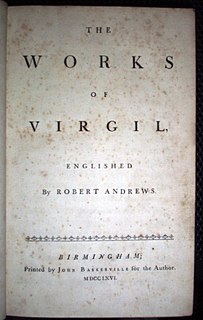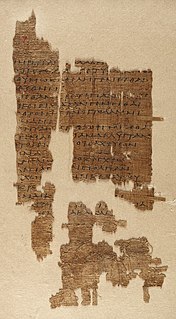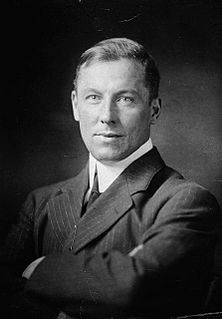A couplet is a pair of successive lines of metre in poetry. A couplet usually consists of two successive lines that rhyme and have the same metre. A couplet may be formal (closed) or run-on (open). In a formal couplet, each of the two lines is end-stopped, implying that there is a grammatical pause at the end of a line of verse. In a run-on couplet, the meaning of the first line continues to the second.
Dactylic hexameter is a form of meter or rhythmic scheme frequently used in Ancient Greek and Latin poetry. The scheme of the hexameter is usually as follows :
The elegiac couplet is a poetic form used by Greek lyric poets for a variety of themes usually of smaller scale than the epic. Roman poets, particularly Catullus, Propertius, Tibullus, and Ovid, adopted the same form in Latin many years later. As with the English heroic couplet, each pair of lines usually makes sense on its own, while forming part of a larger work.

An epigram is a brief, interesting, memorable, and sometimes surprising or satirical statement. The word is derived from the Greek ἐπίγραμμα epígramma "inscription" from ἐπιγράφειν epigráphein "to write on, to inscribe", and the literary device has been employed for over two millennia.
A heroic couplet is a traditional form for English poetry, commonly used in epic and narrative poetry, and consisting of a rhyming pair of lines in iambic pentameter. Use of the heroic couplet was pioneered by Geoffrey Chaucer in the Legend of Good Women and the Canterbury Tales, and generally considered to have been perfected by John Dryden and Alexander Pope in the Restoration Age and early 18th century respectively.
In poetry, metre or meter is the basic rhythmic structure of a verse or lines in verse. Many traditional verse forms prescribe a specific verse metre, or a certain set of metres alternating in a particular order. The study and the actual use of metres and forms of versification are both known as prosody.
Poetry analysis is the process of investigating a poem's form, content, structural semiotics and history in an informed way, with the aim of heightening one's own and others' understanding and appreciation of the work.
An amphibrach is a metrical foot used in Latin and Greek prosody. It consists of a long syllable between two short syllables. The word comes from the Greek ἀμφίβραχυς, amphíbrakhys, "short on both sides".

In prosody, alliterative verse is a form of verse that uses alliteration as the principal ornamental device to help indicate the underlying metrical structure, as opposed to other devices such as rhyme. The most commonly studied traditions of alliterative verse are those found in the oldest literature of the Germanic languages, where scholars use the term 'alliterative poetry' rather broadly to indicate a tradition which not only shares alliteration as its primary ornament but also certain metrical characteristics. The Old English epic Beowulf, as well as most other Old English poetry, the Old High German Muspilli, the Old Saxon Heliand, the Old Norse Poetic Edda, and many Middle English poems such as Piers Plowman, Sir Gawain and the Green Knight, and the Alliterative Morte Arthur all use alliterative verse.

Blank verse is poetry written with regular metrical but unrhymed lines, almost always in iambic pentameter. It has been described as "probably the most common and influential form that English poetry has taken since the 16th century", and Paul Fussell has estimated that "about three quarters of all English poetry is in blank verse".

"Annabel Lee" is the last complete poem composed by American author Edgar Allan Poe. Like many of Poe's poems, it explores the theme of the death of a beautiful woman. The narrator, who fell in love with Annabel Lee when they were young, has a love for her so strong that even angels are envious. He retains his love for her even after her death. There has been debate over who, if anyone, was the inspiration for "Annabel Lee". Though many women have been suggested, Poe's wife Virginia Eliza Clemm Poe is one of the more credible candidates. Written in 1849, it was not published until shortly after Poe's death that same year.

The Sapphic stanza, named after Sappho, is an Aeolic verse form of four lines. Originally composed in quantitative verse and unrhymed, since the Middle Ages imitations of the form typically feature rhyme and accentual prosody. It is "the longest lived of the Classical lyric strophes in the West".
Iambic pentameter is a type of metric line used in traditional English poetry and verse drama. The term describes the rhythm, or meter, established by the words in that line; rhythm is measured in small groups of syllables called "feet". "Iambic" refers to the type of foot used, here the iamb, which in English indicates an unstressed syllable followed by a stressed syllable. "Pentameter" indicates a line of five "feet".
The Iambic trimeter is a meter of poetry consisting of three iambic units per line.
Iambic tetrameter is a meter in poetry. In ancient Greek and Latin poetry, it is the name of a rhythm of four metra, each metron being of the form | x – u – |, consisting of a spondee and an iamb, or two iambs. There is usually a break in the centre of the line, thus the whole line is:
| x – u – | x – u – || x – u – || x – u – |

Mariano Brull Caballero was a Cuban poet usually associated with the French Symbolist movement. Two Symbolists who strongly influenced him were Stéphane Mallarmé and Paul Valéry. Among Cuban poets of the first half of the 20th century he was the most outstanding of those who wrote poetry for poetry's sake, as opposed to poetry that addressed social issues or poetry that was inspired by the culture of Cubans of African descent. Because of his interest in the sounds of words, he is known for a type of poetry called "jitanjáfora" in which the words are virtually meaningless, their sounds all-important. A diplomat by profession, he lived many years in various countries of Europe and the Americas.
Masculine ending and feminine ending are terms used in prosody, the study of verse form. "Masculine ending" refers to a line ending in a stressed syllable. "Feminine ending" is its opposite, describing a line ending in a stressless syllable. This definition is applicable in most cases; see below, however, for a more refined characterization.

Robert William Service was a British-Canadian poet and writer, often called "the Bard of the Yukon". The middle name 'William' was in honour of a rich uncle. When that uncle neglected to provide for him in his will, Service dropped the middle name.
The Poema Morale is an early Middle English moral poem outlining proper Christian conduct. The poem was popular enough to have survived in seven manuscripts, including the homiletic collections known as the Lambeth Homilies and Trinity Homilies, both dating from around 1200.
"You can shed tears that she is gone..." is the opening line of a piece of popular verse, based on a short prose poem, "Remember Me", written in 1982 by English painter and poet David Harkins. The verse – sometimes also known as "She Is Gone" – has often been given an anonymous attribution, but Harkins claimed his original authorship after it was chosen by Queen Elizabeth II as part of the funeral ceremony for her mother, Queen Elizabeth The Queen Mother, in April 2002. It has subsequently become a popular choice to be read at funeral ceremonies, although according to Harkins it was originally written about unrequited love, rather than death.






